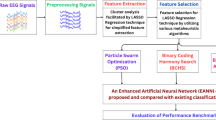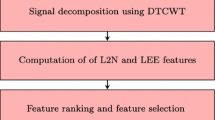Abstract
(Aim) Alcohol use disorder may put health at risk and cause serious health problems. It is of increasing importance to identify alcohol use disorder as early as possible. (Method) This study proposed a computer-vision based technique. The dataset was scanned by magnetic resonance imaging in China participating hospitals. Afterwards, we combined wavelet entropy, two-layer feedforward neural network, and cat swarm optimization (CSO). The CSO mimics the behavior of cat and is composed of two modes: seeking mode and tracing mode. (Results) The results showed that our method achieves a sensitivity of 91.84 ± 1.66%, a specificity of 92.40 ± 1.22%, and an accuracy of 92.13 ± 0.70%. Using grid searching approach, we found the classification performance is the best, when decomposition level is assigned with 2 and the mixture ratio is assigned with a value of 0.8. (Conclusion) The CSO is superior to four bioinspired algorithms: genetic algorithm, immune genetic algorithm, particle swarm optimization, and chaotic self-adaptive particle swarm optimization. In addition, our proposed alcoholism identification system is superior to four state-of-the-art alcoholism detection approaches.















Similar content being viewed by others
References
Abou El-Ela AA et al. (2016) Optimal placement and sizing of distributed generation units using different cat swarm optimization algorithms. in 18th Eighteenth International Middle East Power Systems Conference (MEPCON). Cairo, EGYPT: IEEE. p. 975–981
Alweshah M, Abdullah S (2015) Hybridizing firefly algorithms with a probabilistic neural network for solving classification problems. Appl Soft Comput 35:513–524
Atangana A (2018) Application of stationary wavelet entropy in pathological brain detection. Multimed Tools Appl 77(3):3701–3714
de Carvalho CAM et al (2016) Morphological and immunohistochemical analysis of apoptosis in the cerebellum of rats subjected to focal cerebral ischemia with or without alcoholism model. Acta Cir Bras 31(9):629–637
Chen Y (2017) A Feature-Free 30-Disease Pathological Brain Detection System by Linear Regression Classifier. CNS Neurol Disord Drug Targets 16(1):5–10
Chen Y, Chen X-Q (2016) Sensorineural hearing loss detection via discrete wavelet transform and principal component analysis combined with generalized eigenvalue proximal support vector machine and Tikhonov regularization. Multimed Tools Appl 77(3):3775–3793
Chen Y, Lu H (2018) Wavelet energy entropy and linear regression classifier for detecting abnormal breasts. Multimed Tools Appl 77(3):3813–3832
Chen S, Yang J-F, Phillips P (2015) Magnetic resonance brain image classification based on weighted-type fractional Fourier transform and nonparallel support vector machine. Int J Imaging Syst Technol 25(4):317–327
Chen RM, Yang SC, Wang CM (2017) MRI brain tissue classification using unsupervised optimized extenics-based methods. Comput Electr Eng 58:489–501
Chu SC, Tsai PW, Pan JS (2006) Cat Swarm Optimization. in 9th Pacific Rim International Conference on Artificial Intelligence (PRICAI). Guilin, P R CHINA: Springer-Verlag Berlin. p. 854–858
Darvishvand L, Kamkari B, Kowsary F (2018) Optimal design approach for heating irregular-shaped objects in three-dimensional radiant furnaces using a hybrid genetic algorithm-artificial neural network method. Eng Optim 50(3):452–470
Du S (2016) Multi-objective path finding in stochastic networks using a biogeography-based optimization method. SIMULATION 92(7):637–647
Fabijanska A (2017) Corneal Endothelium Image Segmentation Using Feedforward Neural Network. in Federated Conference on Computer Science and Information Systems (FedCSIS). Prague, Czech Republic: IEEE. p. 629–637
Feng JH et al (2017) A novel chaos optimization algorithm. Multimed Tools Appl 76(16):17405–17436
Gao ML et al (2016) Research of resistivity imaging using neural network based on immune genetic algorithm. Chin J Geophys-Chin Ed 59(11):4372–4382
Gupta L et al (2017) Wavelet Entropy of BOLD Time Series: An Application to Rolandic Epilepsy. J Magn Reson Imaging 46(6):1728–1737
Han L (2018) Identification of Alcoholism based on wavelet Renyi entropy and three-segment encoded Jaya algorithm. Complexity 2018:3198184
Hou X-X (2017) Alcoholism detection by medical robots based on Hu moment invariants and predator-prey adaptive-inertia chaotic particle swarm optimization. Comput Electr Eng 63:126–138
Huo YK et al (2017) Simultaneous total intracranial volume and posterior fossa volume estimation using multi-atlas label fusion. Hum Brain Mapp 38(2):599–616
Huo YK et al (2018) Robust Multicontrast MRI Spleen Segmentation for Splenomegaly Using Multi-Atlas Segmentation. IEEE Trans Biomed Eng 65(2):336–343
Jenitta A, Ravindran RS (2017) Image Retrieval Based on Local Mesh Vector Co-occurrence Pattern for Medical Diagnosis from MRI Brain Images. J Med Syst 41(10):157
Jia W (2017) Three-Category Classification of Magnetic Resonance Hearing Loss Images Based on Deep Autoencoder. J Med Syst 41(10):165
Jiang Y (2017) Exploring a smart pathological brain detection method on pseudo Zernike moment. Multime Tools Appl. https://doi.org/10.1007/s11042-017-4703-0
Jiang YY (2017) Cerebral Micro-Bleed Detection Based on the Convolution Neural Network With Rank Based Average Pooling. IEEE Access 5:16576–16583
Kumar Y, Sahoo G (2017) An Improved Cat Swarm Optimization Algorithm Based on Opposition-Based Learning and Cauchy Operator for Clustering. J Inf Process Syst 13(4):1000–1013
Li MS et al (2013) Solubility Prediction of Gases in Polymers based on Chaotic Self-adaptive Particle Swarm Optimization Artificial Neural Networks. Acta Chim Sin 71(7):1053–1058
Li G et al (2018) Modeling of ash agglomerating fluidized bed gasifier using back propagation neural network based on particle swarm optimization. Appl Therm Eng 129:1518–1526
Liu SG et al (2016) A novel label learning algorithm for face recognition. Signal Process 124:141–146
Liu SG et al (2017) Improved sparse representation method for image classification. IET Comput Vis 11(4):319–330
Lu S, Lu Z (2018) A pathological brain detection system based on kernel based ELM. Multimed Tools Appl 77(3):3715–3728
Monnig MA (2012) Observed power and projected sample sizes to detect white matter atrophy in neuroimaging of alcohol use disorders. Alcohol-Clin Exp Res 36:272A–272A
Mostafa A et al (2017) Liver segmentation in MRI images based on whale optimization algorithm. Multimed Tools Appl 76(23):24931–24954
Murano T, Hagihara H, Miyakawa T (2016) Transcriptomic immaturity of hippocampus and prefrontal cortex in patients with alcoholism. Int J Neuropsychopharmacol 19:170–171
Nie XH, Wang W, Nie HY (2017) Chaos Quantum-Behaved Cat Swarm Optimization Algorithm and Its Application in the PV MPPT. Computational Intelligence and Neuroscience, Article ID. 1583847
Ong HH et al (2018) Genetic polymorphisms of alcohol-metabolizing enzymes and their association with alcoholism risk, personality and anthropometric traits among Malaysian university students. Psychol Health Med 23(2):160–170
Pan H, Zhang C, Tian Y (2014) RGB-D image-based detection of stairs, pedestrian crosswalks and traffic signs. J Vis Commun Image Represent 25(2):263–272
Piersanti S, Orlandi A (2018) Genetic Algorithm Optimization for the Total Radiated Power of a Meandered Line by Using an Artificial Neural Network. IEEE Trans Electromagn Compat 60(4):1014–1017
Shahrabi J, Khameneh SM (2017) Development of a hybrid system of artificial neural networks and artificial bee colony algorithm for prediction and modeling of customer choice in the market. J Fundam Appl Sci 9:154–183
Shoaib M et al (2018) A Comparative Study of Various Hybrid Wavelet Feedforward Neural Network Models for Runoff Forecasting. Water Resour Manag 32(1):83–103
Subramaniam S, Radhakrishnan M (2016) Neural Network with Bee Colony Optimization for MRI Brain Cancer Image Classification. Int Arab J Inf Technol 13(1):118–124
Sun P (2016) Preliminary research on abnormal brain detection by wavelet-energy and quantum-behaved PSO. Technol Health Care 24(s2):S641–S649
Wei L, Yang J (2016) Fitness-scaling adaptive genetic algorithm with local search for solving the Multiple Depot Vehicle Routing Problem. SIMULATION 92(7):601–616
Wolber N et al (2018) The Simplest Idea Is the Best Idea. J Neurosci Nurs 50(1):22–23
Xun YQ et al. (2016) Ant Colony Based on Cat Swarm Optimization and Application in Picking Robot Path Planning. in 7th International Conference on Software Engineering and Service Science. Beijing, China: IEEE. p. 162–165
Yang J (2017) Pathological brain detection in MRI scanning via Hu moment invariants and machine learning. J Exp Theor Artif Intell 29(2):299–312
Zhan TM, Chen Y (2016) Multiple Sclerosis Detection Based on Biorthogonal Wavelet Transform, RBF Kernel Principal Component Analysis, and Logistic Regression. IEEE Access 4:7567–7576
Zhou X-X et al (2016) Combination of stationary wavelet transform and kernel support vector machines for pathological brain detection. SIMULATION 92(9):827–837
Acknowledgments
This paper is financially supported by Natural Science Foundation of China (61602250), Natural Science Foundation of Jiangsu Province (BK20150983), Project of Science and Technology of Henan Province (172102210272), Program for Science & Technology Innovation Talents of Henan Province (174100510009), Open fund for Jiangsu Key Laboratory of Advanced Manufacturing Technology (HGAMTL1601, HGAMTL-1703), Open fund of Key Laboratory of Guangxi High Schools Complex System and Computational Intelligence (2016CSCI01), Open Fund of Guangxi Key Laboratory of Manufacturing System & Advanced Manufacturing Technology (17-259-05-011 K)., Henan Key Research and Development Project (182102310629), National key research and development plan (2017YFB1103202)
Author information
Authors and Affiliations
Corresponding authors
Ethics declarations
Conflict of interest
The authors declare there is no conflict of interest with regard to this submission.
Rights and permissions
About this article
Cite this article
Zhang, YD., Sui, Y., Sun, J. et al. Cat Swarm Optimization applied to alcohol use disorder identification. Multimed Tools Appl 77, 22875–22896 (2018). https://doi.org/10.1007/s11042-018-6003-8
Received:
Revised:
Accepted:
Published:
Issue Date:
DOI: https://doi.org/10.1007/s11042-018-6003-8




